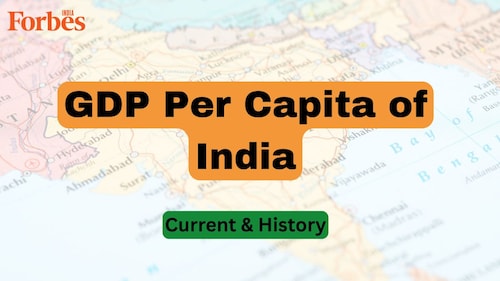GDP per capita of India: Current & historical data (2015 to 2025)
Find out the past and current GDP per capita of India. Know why it's essential and where India ranks in the global economy


The Indian economy has seen it all - from moments of uncertainty in the early 90s to slowdowns and promising surges over the last few years. From an agriculture-driven economy to a global hub for services and manufacturing, India has seen tremendous growth across sectors. But how do we measure the impact of this progress on individual success?
This is where Gross Domestic Product (GDP) per capita acts as a key indicator of overall economic growth. India"s GDP per capita has shown significant growth in recent years, reaching over $2,310 in 2024. This figure represents approximately 18 percent of the world"s average, indicating that while India has made progress, there is still room for improvement compared to global standards.
India’s GDP per capita this year is estimated to be $2,940 and is expected to grow to nearly $4,195 by 2029. The country’s economic trajectory is a mix of industrial growth, demographic shifts, and global market influences. Compared to China, which had already reached a GDP per capita of $6,995 in 2013, India still has a long way to go.
In this article, we’ll discuss what GDP per capita is, its current standing, historical data, and what these numbers mean for the Indian economy and its future.
GDP per capita provides a clear picture of the country’s income levels and purchasing power. There are two ways to look at this metric: Nominal GDP per capita reflects the economy"s size using current prices and exchange rates. GDP per capita, based on purchasing power parity (PPP), accounts for the cost of living, purchases, and other price differences. Together, it helps you to assess how much wealth is distributed among its population. A higher GDP per capita generally indicates better living standards and economic prosperity.
Nominal GDP per capita is calculated by:

The metric is widely used to compare economic performance across the globe. Nations with strong industrial and service sectors, such as the United States and China, often have high GDP per capita, whereas densely populated or developing economies may have lower figures. For India, this number provides insights into economic growth, making it a crucial factor in understanding the country’s progress.
The current outlook for India"s GDP per capita is positive. The International Monetary Fund (IMF) expects India"s real GDP growth to be 6.5 percent this year. As of the latest data for Q3 FY2024-25, India"s real GDP grew by 6.2 percent, indicating a rapid recovery from the 5.6 percent growth in the previous quarter.
The Indian economy is showing strong momentum, with GDP growth for FY2023-24 recorded at 9.2 percent—the highest in 12 years, excluding the post-COVID rebound. The IMF also stated that India’s GDP per capita is estimated to reach nearly $2,880 in 2025, positioning India as one of the fastest-growing global economies due to stable commodity prices, cooling food inflation, and normal monsoons. With steady growth projections, this indicates a rising GDP per capita, reflecting improved income levels and economic progress.
Many elements shape India’s GDP per capita. It"s a mix of factors, including the number of people, the cost of things, the skill level of the workforce, and more.
First Published: Apr 24, 2025, 17:24
Subscribe Now